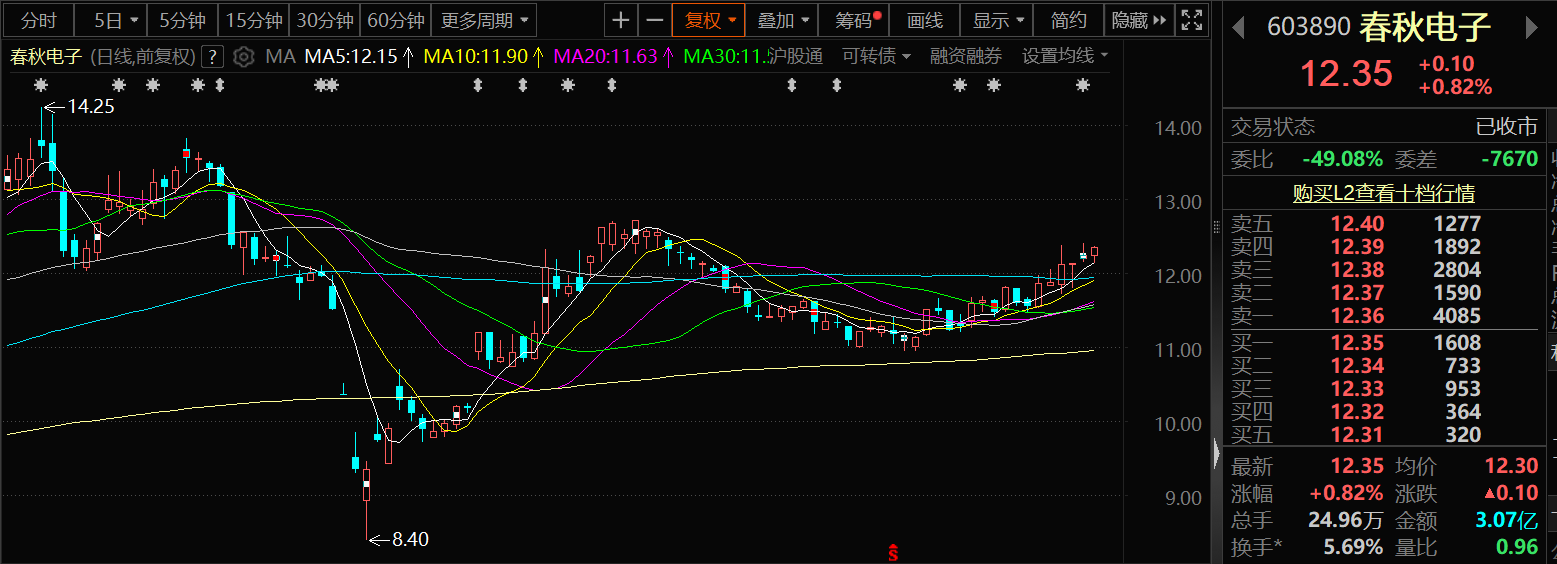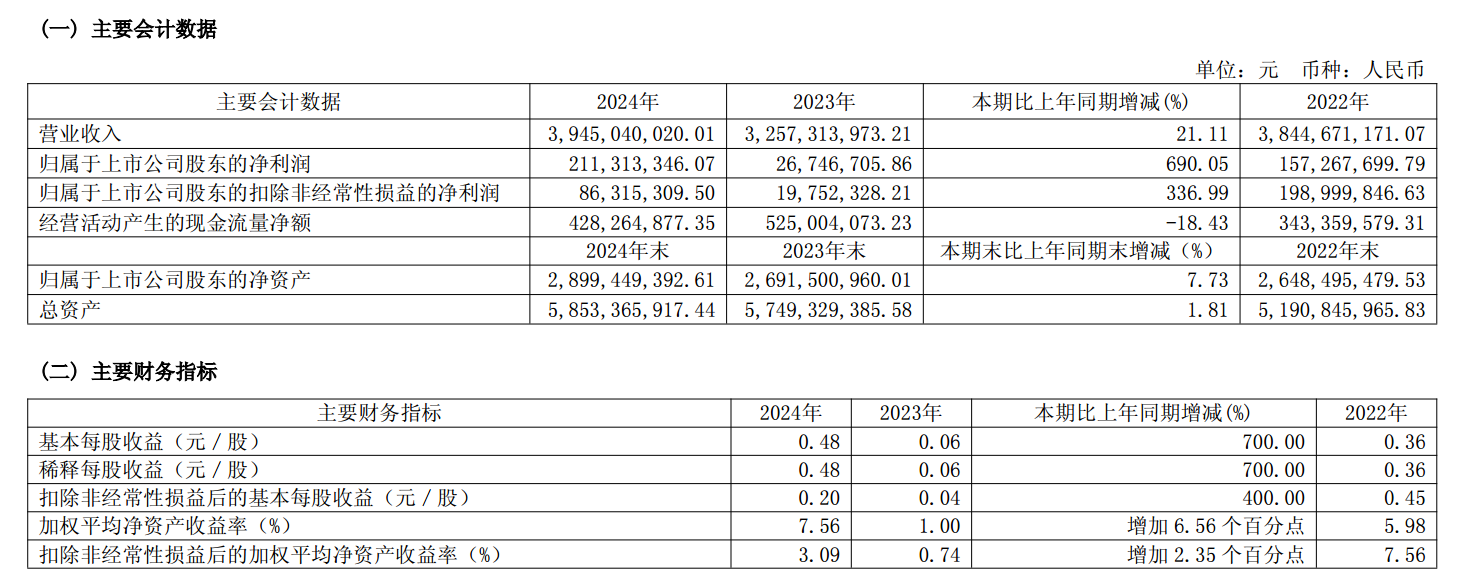






Chunqiu Electronics' stock price rose on July 15. By the close of trading on the 15th, Chunqiu Electronics had risen by 0.82%, closing at 12.35 yuan per share.

In its semi-annual performance forecast released on July 14, Chunqiu Electronics stated: Based on preliminary calculations by the financial department, it is expected that the net profit attributable to owners of the parent company for the first half of 2025 will range from 90 million yuan to 110 million yuan. Compared with the same period last year (legally disclosed data), this represents an increase of 63.2179 million yuan to 83.2179 million yuan, up 236.05% to 310.72% YoY. Additionally, it is expected that the net profit attributable to owners of the parent company, excluding non-recurring gains and losses, for the first half of 2025 will range from 65 million yuan to 85 million yuan. Compared with the same period last year (legally disclosed data), this represents an increase of 49.2481 million yuan to 69.2481 million yuan, up 312.65% to 439.62% YoY.
Regarding the main reasons for the anticipated increase in performance, Chunqiu Electronics stated:In the first half of the year, the notebook computer structural parts business benefited from the rapid penetration of AIPC, and the magnesium alloy application business for NEVs benefited from the rapid development of the NEV industry. The company's main businesses remained stable and improved. At the same time, the company maintained its strategic focus, optimized resource allocation, strengthened internal management, maintained high operational efficiency, significantly enhanced market competitiveness and profit margins, providing support and driving the company's performance.
In response to the question, "What are the main products and businesses that the company currently cooperates with Huawei on? Additionally, with the automotive electronics magnesium alloy business entering the mass production stage, who are the current partners, and what is the sales situation of the products?" Chunqiu Electronics responded on the investor interaction platform on June 27:The company has obtained certifications from multiple well-known automotive electronics producers in the automotive magnesium alloy application business and has formed business relationships with multiple NEV manufacturers and their suppliers. Downstream products cover NEV car models from Xiaomi, NIO, XPeng, BYD, BMW, Geely, Volkswagen, etc. The products that the company cooperates with Huawei on are mainly notebook computer structural parts.
Chunqiu Electronics' previously released 2024 annual report showed: In 2024, the company achieved a total operating revenue of 3.945 billion yuan, up 21.11% YoY; net profit attributable to shareholders was 211 million yuan, up 690.05% YoY. The current period's operating revenue increased by 687,726,046.8 yuan compared with the previous period, representing a 21.11% increase YoY. This was mainly due to the recovery of the notebook computer industry and the growth in orders for the automotive electronics business.

Chunqiu Electronics also announced its business plan in its 2024 annual report: The company's main businesses focus on the preparation of structural parts and related precision molds for consumer electronics products. The company's future business operation plan is as follows:
(I) Structural Components for Consumer Electronics In the future, the company will continue to strengthen its competitive advantages in structural components for consumer electronics. By leveraging its core material application and product development capabilities, as well as its automated system integration capabilities, the company aims to win more high-quality downstream customers, steadily advance its structural components business for consumer electronics, and achieve steady growth in business scale. The company will further optimize its existing market layout in the industry. On the basis of consolidating its existing market share in plastic structural components for laptops, it will increase investment and expansion efforts in emerging markets with promising demand prospects. The company will continue to increase R&D and investment in the application of new materials for laptops, leveraging its experience and advantages in structural components and precision molds for consumer electronics. It will focus on emerging high-value-added products such as metal stamping, magnesium-aluminum parts, and carbon fiber, deeply explore market demand, enhance profitability, and realize its business planning. Meanwhile, the company will increase R&D efforts and capital investment to complete and upgrade core technologies such as precision mold manufacturing equipment, metal processing, and injection molding, forming exclusive solutions with industry characteristics.
(II) Precision Molds Related to Structural Components for Consumer Electronics Molds are the basic process equipment for industrial production. The industry the company operates in is a typical mold application industry. The quality of molds determines the quality of products, and the technological level and scientific content of mold production largely determine product quality, efficiency, and the ability to develop new products. Relying on its existing precision mold design and manufacturing technologies, the company will accelerate capital, R&D, and personnel investment in precision mold preparation, closely aligning with market development trends, and moving towards large-scale, precision, and complex molds. It will focus on "one-mold, multi-cavity" mold preparation technologies that enhance production efficiency, as well as ultra-precision machining that improves preparation accuracy, further enhancing the specialization and standardization of molds. This will shorten the manufacturing cycle of precision molds, improve mold quality, and reduce mold manufacturing costs. Relying on intelligent manufacturing platforms such as automated processing systems for mold electrode scanning and CNC tool scanning, the company will significantly improve the processing efficiency of precision molds compared to traditional methods. Based on its technological accumulation in laptop structural component manufacturing, the company will timely expand into precision mold businesses for other consumer electronics structural components, which will become a key area for the company's future continuous expansion and another driving force for sustained profit growth. Meanwhile, the company will strive to differentiate itself from competitors through intelligent manufacturing, achieving flexibility, customization, and intelligence in the production process, enhancing production efficiency, product quality, and asset utilization rate. This will enable the company to win the downstream market for high-end consumer electronics structural components and precision molds, thereby enhancing its overall market competitiveness and overall revenue level.
(III) Application of Magnesium-Aluminum Alloy in NEVs According to data from the China Passenger Car Association (CPCA), the retail sales volume of the passenger NEV market reached 10.899 million units in 2024, up 40.7% YoY. According to forecasts by the International Energy Agency, global NEV sales will reach 30 million units by 2025, accounting for 12% of total vehicle sales, and will further increase to 70 million units by 2030, accounting for 26% of total vehicle sales. According to the "Technology Roadmap for Energy Conservation and NEVs" in China, by 2030, the magnesium alloy usage per vehicle in China will reach 45 kg, accounting for 4% of the vehicle's total weight. It is expected that by 2030, the demand for magnesium alloy die-castings in the Chinese automotive market will reach 1.31 million mt, with a compound annual growth rate (CAGR) of 13.2% from 2020 to 2030. The high penetration of magnesium-aluminum alloys in the future is promising. Magnesium alloy has good corrosion resistance, castability, mechanical strength, and is the lightest practical alloy. It also has good machinability, a high strength-to-density ratio (specific strength), stiffness, high thermal conductivity, excellent casting performance, superior shock absorption, and excellent workability, making it the best choice for lightweighting NEVs. The company has years of manufacturing experience and technological advantages in the application of magnesium alloy materials. Through semi-solid injection molding technology, it has rapidly entered the parts supply chain for NEVs in the lightweighting trend of NEVs, providing application support for the central control system, steering system, and electronic control system of NEVs.
The price fluctuations of magnesium alloy are closely related to those of the raw material magnesium ingot. A review of the magnesium price trend in the first half of the year shows:
》Click to view SMM magnesium spot price
》Subscribe to view historical SMM metal spot price trends
In the first half of this year, magnesium prices showed characteristics of "narrow gains but frequent fluctuations," as detailed below: From a price movement perspective, taking the average price of SMM magnesium ingot 9990 (Fugu, Shenmu) as an example, the average price on December 31, 2024, was 16,000 yuan/mt, and on June 30, 2025, it was 16,200 yuan/mt, with a cumulative gain of only 1.25% in the first half of the year, indicating relatively limited gains. However, the price fluctuations were frequent and of significant magnitude: the highest average price in the first half of the year occurred on May 13 and 14, reaching 17,450 yuan/mt; the lowest point was on March 6 and 7, dropping to 15,050 yuan/mt, with a price spread of 2,400 yuan/mt between the highest and lowest points. Behind this trend, it was mainly influenced by changes in the supply-demand pattern and disruptions from news: on the one hand, the long-term and concentrated shutdowns of magnesium plants in the first half of the year gradually reversed the "strong supply, weak demand" pattern in the magnesium market, with tight spot supply and low inventory levels laying the fundamental groundwork for periodic magnesium price increases; on the other hand, news such as "solid waste slag burying," "shutdown of dolomite mines in the Wutai area," and "the arrival of environmental protection inspection teams" continued to disrupt market sentiment, exacerbating price fluctuations. Overall, magnesium prices in H1 exhibited a trend characterized by "low early, high later, jumping initially and then pulling back, and fluctuating rangebound at the bottom."
On July 15, the price of SMM magnesium ingot 9990 (Fugu, Shenmu) ranged from 16,200 to 16,300 yuan/mt, with an average of 16,250 yuan/mt, flat from the previous trading day. The current magnesium market shows a weak supply and demand pattern. Supply side, producer inventories in the Fugu region remain low. Although environmental protection review news once disturbed the market, the actual production impact was limited, and overall supply remained relatively stable. Demand side, as the concentrated delivery date period ended, procurement by downstream magnesium powder and alloy plants slowed down, traders' wait-and-see sentiment intensified, and market transactions were sluggish. Short term, the supply side lacks expectations of significant contraction, while end-use demand shows no clear recovery, leaving insufficient support for price increases. If demand remains weak later, coupled with production resumptions by some producers, the market may continue in the doldrums, with prices mainly fluctuating rangebound.
Recommended reading:
For queries, please contact Lemon Zhao at lemonzhao@smm.cn
For more information on how to access our research reports, please email service.en@smm.cn